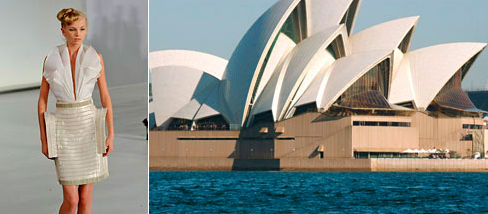 |
| Don Ashby, Reuters A Spring 2009 look from Gianfranco Ferré and the Sydney Opera House |
It is surprising to learn that top designers such as Tom Ford and Gianni Versace started their design education within the world of architecture. Fashion design and architecture are some of the most fast paced jobs in the design field. For a fashion designer, it is easy to create over ten collections consisting of around 10 - 20 looks, and an architect can have over fifteen big projects, both within the span of one year. Their massive workload, unfortunately, can cause them to not only lose their creativity in their own work, but can lessen their inspirations. For designers, getting inspirations from other design fields is a large part of their own design. Not until recently, architects have been designing stores for luxury brands such as Rem Koolhaas's designs for the Prada Store in New York, and architects are slowly combining their own designs with the aesthetics found in fashion designs.
 |
| Vintage Versace Jacket |
The famous fashion brand, Prada, and well known architect, Rem Koolhaas, have a close relationship within their fields, bridging the gap between fashion and architecture, and bringing them even closer than they already are.
Rem Koolhaas is a Dutch architect who studied architecture in both London and New York. In 2000, Rem Koolhaas was given the Pritzker Prize, which is compared to winning the Grammys, but for architectural achievements. Eight years later,
 |
| Versace Mansion in Miami, FL |
 |
| Interior Perspective, Prada Flagship Store in NY Designed by Rem Koolhaas |
What Rem Koolhaas has designed is simply a space that grabs the attention of any shopper that comes into the store. The interior of the Prada store is not only displaying the clothing of Prada, but it is also an art installation. Every single design aspect of this Prada store has some type of function and purpose, similar to a painting; the focal point of the painting draws the attention of the viewer in and slowly lets the viewer’s eye glide throughout the painting. This is exactly what Rem Koolhaas has done with the Prada store. There are multiple points of interest throughout and it lets the customers roam freely around the space.
 |
| Dress designed by Gianfranco Ferre |
Another pioneer in the mixed world of fashion and architecture is designer Gianfranco Ferre. He first entered the world of design after graduating from Milan University in 1969 with a degree in architecture. During that time, the chances for an architect to succeed were very slim. He was trying to figure out a career for himself and the closest path to architecture was fashion. He says, "Architecture is, after all, a search for solution of form, shape, and color and so it is with fashion." I strongly agree with this quote. Architecture and fashion are two entirely different mediums, but I believe that architecture is just a larger scale of fashion. What I mean by this is that architecture and fashion design are both created to contain the human body, the only difference being the scale at which it is displayed. The two mediums both have to do with shape, space, and how it interacts with the environment.
In the beginning of Gianfranco's career, he was highly criticized by how stiff his designs were, and again after he completely changed his collection for the Spring and Summer. The garments are anything but stiff; they are made of soft fabrics that flow off
the body. Using fabrics such as light wool, silk, and gabardine, Gianfranco was able to achieve this effect with his clothes. Even though his designs transitioned from stiff to loose, the character that the stiffness introduced from the previous design was not lost but instead used to show the movement of the body through the loose fabrics.
Architecture and Fashion Design collaborations are being seen more frequently in recent years. As the two different worlds manage to blend into each other, the design inspiration is infinite. The ideas from one another only push the envelope of what is possible and what might happen in the future.
In the beginning of Gianfranco's career, he was highly criticized by how stiff his designs were, and again after he completely changed his collection for the Spring and Summer. The garments are anything but stiff; they are made of soft fabrics that flow off
 |
| Dress designed by Gianfranco Ferre |
Architecture and Fashion Design collaborations are being seen more frequently in recent years. As the two different worlds manage to blend into each other, the design inspiration is infinite. The ideas from one another only push the envelope of what is possible and what might happen in the future.
-Tommy-

0 comments :
Post a Comment
Thank you for commenting on O ZINE! It may appear soon.